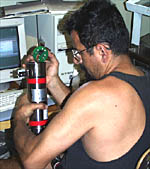|
|
  TODAY'S WEATHER Blue skies, scattered clouds 83.3°F (28.5°C) Latitude: 9 deg 50.5’N Longitude: 104 deg 17.6 ’W Wind Direction: E Wind Speed: 12 Knots Sea State 0 Swell(s) Height: 4-6 Foot Sea Temperature: 84°F (28.9°C) Barometric Pressure: 1014.4 MB Visibility: 10-25 Nautical Miles  Breakfast Dry Cereal Toast, English Muffins and Bagels Hash browns and poached eggs Fresh Fruit Home-made dougnuts Lunch Ginger Chicken Shrimp fried rice Stir fried vegetables Egg rolls Salad Bar Cookies and Ice Cream Bars Dinner NY strip steak Potato skins Steamed Mussels Salad Bar Orange cake with frosting  Rob Palomares, Scripps’ technician, dismantles two of the Miniature Autonomous Plume Recorders (MAPR) to replace their batteries and get them working again. Clear sailing, then a glitch At 0730 hours--18 minutes ahead of schedule--we arrived at the first site where we will begin surveying the seafloor. Yesterday we had estimated that we would arrive at 0748 hours. The ship’s engines ran at the same speed through the night, so what could have made the ship move faster than we anticipated? (The answer is at the bottom of today’s Daily Journal). Now the work really begins, and everyone has revved up into high gear. Jim Charters and Uta Peckman of Scripps started testing the ship’s multibeam sonar. Technicians from the Woods Hole Oceanographic Institution-Deep Submergence Operations Group (WHOI-DSOG) prepared the DSL-120 sonar vehicle for its first lowering to the seafloor. Tom Crook from WHOI and Melville Captain Buck worked out a minor problem in linking the DSL-120 computers with the ship’s Dynamic Positioning (DP) system, which ensures that the ship maintains its position in a rolling ocean. Meanwhile, Melville Bosun Bill Kamholtz and his deck crew were busy fighting the continual war against rust. Maintaining the ship in a corrosive saltwater environment is one of the crew’s important responsibilities. At 1542 hours, Bob “Yogi” Elder, the WHOI-DSOG expedition leader, organized the launching of the DSL-120 with Ron Comer, Scripps’ resident technician, and PJ Bernard of the WHOI-DSOG team. As the long, sleek DSL-120 is towed through waters near the seafloor, it resembles a swimming fish, so we often call it the “sonar fish”. Rob Palomares, a Scripps’ technician, helped us prepare little MAPRs (Miniature Autonomous Plume Recorders), which monitor water properties and temperatures. We are installing four MAPRs on a fiber-optic cable above the sonar fish and another one below it, so that we get a close look at the water properties near the bottom. As we tow the sonar fish above the mid-ocean ridge, these recorders will help us locate hydrothermal vents. It takes several hours to lower the DSL-120 to the seafloor. At about 1900 hours, as the sonar fish approached the bottom, things did not go according to plan. The DSL-120 was not “pinging”. The sonar fish sends out sound signals, or “pings”, which bounce off seafloor structures. If the DSL-120 does not send out signals, no echoes return, and we get a blank record. That’s what happened. On oceanographic expeditions, the only sure thing is that there is no sure thing. Despite all your planning, you have to count on something going wrong. And then, in the middle of the ocean, you have to fix the problem--fast. After a lot of testing and thinking, Yogi and the other WHOI technicians decided that they had to haul the sonar back up on deck to check out its electronics. It promises to be a long night of work to fix the sonar. The DSL-120 system is a complex piece of electronic and acoustic equipment, and many things can go wrong. But the WHOI technicians are very familiar with all its quirks, and we are optimistic that they will figure out and fix the problem. The situation is frustrating for everyone on board, but not unusual. Anyone who has ever gone to sea is used to these situations. Answer to Question:
|
|||||||||||||||||||||||||||||||||||||||||||||||||||||||||||||||||||||||||||||||||||||||||||||||||||||||||||||||||||||||||||||||||||||||||||||||||||||||||||||||||||
© 2010 Dive and Discover™. Dive and Discover™ is a registered trademark of
Woods
Hole Oceanographic Institution
